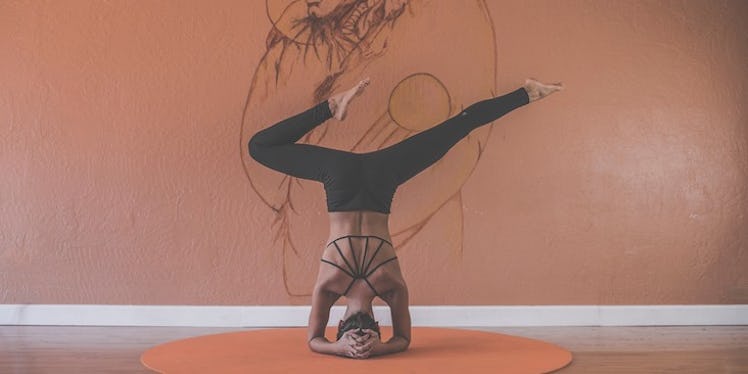
You Might Get Dizzy Flowing Through These 3 Yoga Poses, But Here's How To Beat The Vertigo
As a yoga teacher, I'm a strong believer in the fact that a quality, relaxing yoga flow can truly do no wrong. However, there's nothing worse than the feeling when you're chilling in forward fold and a wave of nauseous dizziness hits you like a truck. Like, I'm pretty sure I came to yoga class to find inner peace and sh*t, so why do I feel this way? For real though, can yoga cause vertigo?
Personally, the first time this happened to me, I low-key thought I was dying. And since no one really talks about experiencing vertigo during vinyasa, it's not that farfetched to think you're literally doing something wrong.
But yoga-induced vertigo is actually more common than you may think, and it even has a scientific name. Getting woozy during your warrior sequence is more formally known as benign paroxysmal position vertigo, which is a condition that causes tiny parts in your inner ear to become dislodged, thus throwing your entire body off-balance.
Ugh, seriously? I do yoga because I'm literally trying to locate my balance, and this happens. Why do you do this to me, body?
There are particular asanas that tend to trigger that "room spinning out of control" sensation, though, and the culprits are usually when your head is positioned below your heart. Here are a few yoga poses that may be causing you to feel lightheaded AF.
1. Headstand (Sirsasana)
Since people don't typically chill upside down on the reg, getting accustomed to inverting your body can cause all kinds of weird sensations at first.
When you first begin practicing headstands (or any other types of inversions, such as a forearm stand or handstand), you may experience a rush of blood to your head that can lead to dizziness or vertigo.
Furthermore, if you come out of the pose too quickly, without taking a rest in child's pose, the blood will rush too fast from your head to your lower extremities. The sudden head rush that results typically causes pressure and discomfort, so make sure you move through these poses slowly, always checking in with yourself to see how you're feeling.
2. Upward Bow Pose (Urdhva Dhanurasana)
You might not think of upward bow pose as an inversion, since it's categorized more as a backbend or heart-opener, but since your head is technically below your heart in this one, this too can cause dizzy spells.
Remember that all inversions have the ability to make your blood pressure rise. So if you're prone to high blood pressure and aren't on medication to manage it, it's best to consult with your doctor before inverting, especially so you can avoid suffering from anything more serious than vertigo.
3. Standing Forward Bend (Uttanasana)
Uttanasna is an incredibly relaxing and rejuvenating yoga pose. But, if you're hanging over your legs and suddenly return to an upright position too quickly, you're likely to feel real faint, real fast.
Standing up too quickly from a forward bend can cause a surge of blood to rush down into the legs and abdomen, leaving too little blood to fill the heart.
Don't worry though, your body is smarter than you think, and quickly corrects this by constricting your blood vessels to amp up the pressure in your body.
If vertigo during your flow is a common problem, here are a few ways to keep the dizzy vibes to a minimum.
First, always remember to hydrate properly throughout the day. Being dehydrated can cause blood pressure instability and unpleasant vertigo during your yoga flow. Once you're hydrated, make sure you're moving slowly through your sequences, especially the more challenging poses you haven't quite perfected yet.
This might mean taking your sweet, sweet time as you move out of inverted poses, as well as remembering to always rest in child's pose afterward. For forward folds, be sure to carefully rise up, vertebrae by vertebrae.
Above all, remember that there's no need to rush whatsoever when you're doing yoga, even if you're in a class and it feels like you're "lagging" behind. Your teacher's instructions are simply a guide, never a command. Get to the next pose on your own time, listening to your body only.
Check out the entire Gen Why series and other videos on Facebook and the Bustle app across Apple TV, Roku, and Amazon Fire TV.